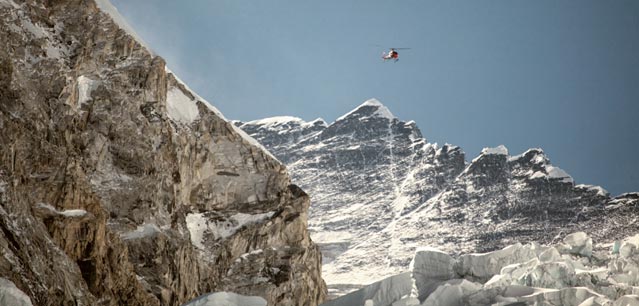On Saturday, April 21, climber Namgya Tshering Sherpa, 30, of Khumjung died after falling roughly 90 feet from a ladder into a crevasse, just below Camp 1 at 5,998 meters (19,678 feet). According to witnesses, Tshering, who was working as a load carrier for Canadian outfitter Peak Freaks, appeared to get a crampon hung up on a ladder rung and was working to get it unstuck when the next porter stepped onto the ladder, causing it to wobble. Tshering briefly clung to one of the safety lines running along the ladder before losing his grip. As I noted in a previous post, rescuers who rappelled into the crevasse a few minutes later immediately recognized that there was nothing to be done.
When I spoke to Peak Freaks owner Tim Rippel, who is also at Everest Base Camp, he had no comment other than to say that Tshering was one of his most experienced hands (“It’s the most difficult day of my life,” he later told his wife, according to ) and that the incident was a careless accident. Careless because, unlike the numerous deaths that have occurred over the years due to icefall collapses or serac avalanches, this one would not have happened if the climber had been clipped into the safety rope running beside the ladder.
The incident underscored one of the less-appreciated dangers porters face on the mountain, which is their confidence in their skills. Climbing Sherpas carry loads so quickly, efficiently, and routinely, that many of them become calloused to the danger of their jobs. It’s not uncommon to see porters bounding, unroped, across ladders as though they were on flat ground. Moving fluidly and fearlessly through the mountains is both a point of pride and a matter of efficiency. It’s also the kind of unsafe habit that drives outfitters nuts. Saturday’s incident prompted a Base Camp-wide meeting of expedition leaders and sirdars to drive home the point that Sherpas, as sure-footed as they are, need to wear crampons and clip into the safety lines.
There’s one other interesting postscript to this story, which is that it resulted the following day in a helicopter body recovery, above 6,000 meters (19,685 feet) in an active avalanche zone. In fact, an avalanche swept down near the recovery team as they were preparing the landing site, causing a scramble. As Nick Heil reported in “Giving Everest the Bird,” as recently as two years ago, this type of high-risk maneuver likely wouldn’t have been attempted. “We send helicopters in for rescues above 19,000 feet,” says Maureen McLaughlin, the public information officer of ‘s Talkeenta District. “But not when there is an undue risk to our personnel. It’s even rarer when it’s a body recovery.” But in the Khumbu, where so many climbers carry medical evacuation insurance, helicopters are on the front line of evacuations.


